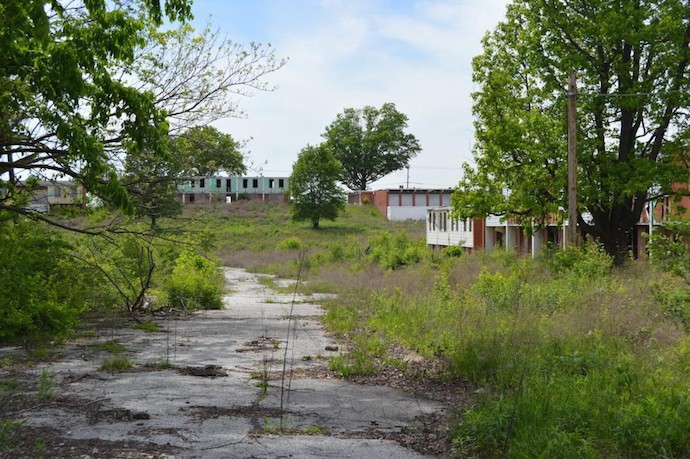In his most recent piece RD associate editor Andrew Aghapour explores why it’s psychologically difficult, but increasingly important, to blame social institutions for causing harm. The article cites an interview with Richard Rothstein, research associate at the Economic Policy Institute, which is available here in full.
For more on this topic, explore It’s Your Fault, a series on blame in contemporary society by RD’s The Cubit.
AA: How did Ferguson become Ferguson?
RR: Throughout the 20th century, federal, state, and local governments implemented policies—not only in St. Louis, but in every metropolitan area in the country—to segregate those areas by race. In St. Louis, it began with the adoption of an ordinance in 1916 prohibiting African Americans from living on blocks where whites were the majority and prohibiting whites from living on blocks where blacks were the majority.
So the purpose of this ordinance was to segregate neighborhoods that were previously integrated. In 1917, the Supreme Court found that such ordinances were unconstitutional—not because they violated African Americans’ rights to live where they could afford to do so, but because they violated the rights of property owners to dispose of their property without state constraint.
Following that Supreme Court decision, the St. Louis city council established a plan commission whose purpose was to zone the city for different types of uses, and racial considerations were an important part of that zoning. In neighborhoods that were filled with single family homes occupied by whites—especially where those homes had deeds that prohibited resale to African Americans—those neighborhoods were given a protective zoning classification so that no commercial uses or multi-family dwellings would be permitted.
In neighborhoods that were occupied by African Americans, the zoning commission gave it a rating that would permit saloons, polluting factories, and certainly multi-family dwellings, turning those neighborhoods eventually into slums. These were important local government efforts to establish residential segregation.
Then the federal government became involved and had a much more powerful influence in segregating the St. Louis metropolitan area. Amidst a national housing shortage, the New Deal proposed both to create employment and to provide housing by building the first civilian public housing in this country. It was built by the Public Works Administration, which established the Neighborhood Composition Rule, holding that public housing had to be inhabited only by people of the same race as those who lived in the neighborhood where it was located.
But, in fact, at that time in the 1930s many urban neighborhoods were somewhat integrated. They weren’t segregated because African Americans, Irish immigrants, Italian immigrants, Jewish immigrants, all had to live close enough to the factories where they worked so that they could walk to work – they didn’t have automobiles.
So in many cases, what the New Deal did was demolish integrated neighborhoods to establish segregated public housing. Segregation was created where it hadn’t existed before by the federal Public Works Administration. And, again, this was done throughout the country.
Then in 1934, the Federal Housing Administration (FHA), another New Deal Program, was created. The FHA had as its purpose to free up mortgage money by ensuring the private mortgages that banks issued, and the FHA had a policy of not insuring mortgages for homes in desegregated neighborhoods. It would only insure mortgages to white families in all white neighborhoods.
Even more pernicious was a policy of the FHA that guaranteed bank loans to mass production builders to create subdivisions—to suburbanize the country—only on condition that no homes be sold to African Americans. This was, again, a nationwide phenomenon. The white suburbs of St. Louis were built in part by developers who had government-backed loans whose terms prohibited any homes in the financed subdivisions from being sold to African Americans.
In 1949, President Truman proposed a National Housing Act to further expand public housing. Projects built nationwide with funds from this program were officially segregated, and one of those massive public housing projects was the famed Pruitt-Igoe Towers in St. Louis. Pruitt was built for black families, the Igoe project was built for white families. They were explicitly segregated.
But whites began to leave public housing. They could buy federally subsidized, racially exclusive, single family homes in the suburbs and could often pay less each month in their carrying charges on these mortgages than they had paid in rent in the public housing projects they had left. So Igoe, which had been built for whites, became a project with a lot of vacancies, while there were long waiting lists for the African American Pruitt project.
The St. Louis Housing Authority eventually permitted black families to be housed in Igoe, and it soon became all black. Industry then moved to the suburbs along with the white population, and the black population in central St. Louis suffered the resulting unemployment and became more impoverished. Pruitt-Igoe became a slum.
The black community in central St. Louis—and again, this is a nationwide phenomenon, I don’t want to give the impression that this was unique to St. Louis—became more slum like, for the reasons I indicated before: because of the way their neighborhoods were zoned; and because they were terribly overcrowded as a result of African Americans having few other places where they were permitted to live. So as the population increased families doubled up because there was no place outside the ghetto where they could move.
This overcrowding became a justification for slum clearance programs. Slums were demolished, and their large African American communities were displaced. The Pruitt-Igoe towers were dynamited. This received a lot of national attention there because they’d become such dysfunctional places to live. And so we have a large inner city black population that was being displaced from the inner city.
You’re probably familiar with the Gateway Arch in St. Louis—it’s a symbol of the gateway to the west; that and the surrounding park is on the site of a former large African American community. The slum clearance not only built the Gateway Arch, it built university extensions, highway interchanges to bring the new suburbanites to their jobs in the downtown area, and the clearance programs forced African Americans out of their previous neighborhoods in the central city. In some cases they were given federal vouchers to subsidize rents outside of their previous areas, but the vouchers were not usable in most places; they were usable in Ferguson.
So large numbers of African Americans who were displaced by urban renewal, by slum clearance in the central city, moved outside the central city, north and west, into places like Ferguson. Since African Americans were prohibited from living in most other places, those communities became predominantly or nearly all black. So that’s how Ferguson became the Ferguson we know today.
Why is this history so important for understanding the African American protests in Ferguson last August?
Well, you have a community now that is heavily low-income with many families receiving some form of public assistance, and a very high unemployment rate because there’s little access to jobs that have moved away. So you have a community that is depressed. In such communities where there’s little hope and high unemployment, there are more single-parent households because there are fewer men who are able to support families. Single parenthood rises, and children grow up in environments where there is little hope and a great deal of stress and deprivation. Many children—particularly the males who have little hope and don’t have jobs—misbehave. Policemen react to repress them based on stereotypes of misbehavior. You then have policing’s racist reactions, young male youth misbehavior, and a cycle develops where each reinforces the other. It’s all attributable to the fact that you have a segregated community where there is little opportunity, no jobs, no public transportation that’s adequate to get people to jobs, and few community resources. You could tell the same story about Baltimore or any other metropolitan area in this country.
This was all described quite adequately some 50 years ago, when there were riots like we saw in Ferguson and Baltimore. Nearly every one of them was provoked by police, either a police killing or unjustified attack on a black male youth or adult. President Johnson appointed the Kerner Commission, headed by the Illinois governor Otto Kerner, to analyze the causes of these riots, over 100 of them in 1967. And the Kerner Commission concluded that the underlying cause of these riots was that we were becoming two societies, one black, one white, separate and unequal.
And the Kerner Commission described many of the conditions that I’ve described to you in the last few minutes, and concluded that so long as we don’t address the segregation of metropolitan areas, we’re going to continue to have these kind of problems. And most everybody received the Kerner Commission report with the view of ‘yes, it’s right, we need to first take care of the violence and restore peace in these communities, and once we’ve done that, then we’ll address the underlying problems.’ But we never got around to addressing the underlying problems, and so these events continued to happen.
The initial response by the government and media was to treat Ferguson as an isolated incident. Then, after public outcry and increased journalistic scrutiny, the focus has shifted to bad policing. You seem to argue that this problem runs deeper. Why is the history of housing so important in understanding the making of Ferguson, and would you argue that this is a deeper, more systemic issue than racist policing?
As I’ve indicated, the police-community dysfunctional relationship is a symptom of the fact that we’ve segregated disadvantaged families in communities where there’s little hope and little opportunity. It’s a reflection of that segregation. Certainly, police practices need to be reformed—there’s no question about that. The recommendations that the Justice Department has made for Ferguson and which it has also made for a number of other cities around the country, are important.
But the problems they’re addressing are a symptom. It’s not to say the symptom shouldn’t be treated, but the underlying cause of these problems is the fact that we’ve segregated housing throughout metropolitan areas in the country for the last century. And unless we are as aggressive in desegregating neighborhoods as we were in segregating them, we can’t expect that treating the symptoms is going to make the problems go away.
This reminds me of Ta-Nehisi Coates’s “The Case for Reparations.” What types of policies or funding would be required to meaningfully respond to this history of segregated housing?
Well, I don’t think of it as reparations, I think of it as remedies, because we have a constitutional theory in this country that says if you have a constitutional violation, you need to have a constitutional remedy. And every one of the practices that I’ve described to you by the federal, state, and local governments, were all violations of the Constitution, and they require remedies.
But it will be quite expensive. Not everything we do in this area will be expensive—we can adopt policies that are not expensive, some modest policies that would make a start—but ultimately, it will be expensive. Let me describe to you some modest policies that we could undertake at very minimal cost.
We now have two federal policies that, in the housing field, are intended to make housing more accessible for low and moderate-income families. One of them is a program run by the Treasury department that gives tax credits to developers who agree to include a small share of units in their developments for low and moderate-income housing.
The problem is that those tax credits are issued to developers who predominantly build developments in already segregated, low-income minority neighborhoods. It’s called the Low-Income Housing Tax Credit Program. And we could easily require that users of the low-income housing tax credits only build in high opportunity communities. And we could prohibit communities from refusing to allow such developments. We could require that any ordinances that prohibit the construction of multi-unit dwellings be repealed. That would be a no-cost option, and it would permit many moderate-income families to relocate from segregated areas where there is no opportunity to middle-class suburban areas.
The other program that the federal government now operates is a voucher program for low-income families. This is not for moderate-income families, but for low-income families. It provides them with vouchers that permit them to rent apartments that they otherwise couldn’t afford at rents typical for their communities. That program also today predominantly subsidizes families to move to already segregated, low-income communities.
We could again prohibit the use of those vouchers, at least for new vouchers that are being issued—I’m not talking about taking away vouchers from families who already have them—we could prohibit the issuing of new vouchers except for use in high opportunity communities. Those are two programs that wouldn’t cost much. We would spend the same money that we now do on the low-income housing tax credit, and on the Section 8 voucher.
Obviously if you’re going to begin seriously to desegregate, you need to provide services that don’t presently exist for transportation for lower-income families in suburban communities. If you did have low-income housing tax credit developments and Section 8 vouchers being used in high opportunity communities, you’d have to provide additional social services and infrastructure to support those families. So that would be a cost factor. But it’s not the major part of the cost of these two programs. So those are two things we could do right away that have very little cost.
We must also reckon with how segregated housing helped to create an economic gulf between white and black communities.
Consider suburban subdivisions that were built in St. Louis or elsewhere in the country, for example, Levittown outside New York City. They were built, as I mentioned, in the 1940s and 1950s with federal government guaranteed loans and the stipulation that no homes be sold to African Americans. At the time, those suburban single family homes were sold to white families for about two and a half times national mediate income, or in today’s dollars, about $125,000. That’s a home price that was affordable with an FHA or VA mortgage to working class families, black or white. Many black families could have afforded those homes in the late 1940s and 1950s, but they were prohibited from purchasing them by FHA policy.
Today, those homes sell for $500,000 or $600,000. We now have a law, the Fair Housing Act, which says that African Americans are free to live anywhere they want. They can live in Levittown, they can live in the suburbs of St. Louis. But it’s not an effective remedy to tell people that they can now move to neighborhoods that have become unaffordable, when they, or their parents or grandparents, could have moved there when the homes were affordable 50 or 60 years ago. The result is that white working class families that moved to suburban communities with a federal subsidy 50 or 60 years ago have gained over the course of the last half-century $300,000 or $400,000 in equity as a result of the appreciation of their home values.
This wealth sent their children to college, provided for illness, meant their children didn’t have to support them in retirement. And they bequeathed some of this wealth to their children and grandchildren. Black families who were denied the opportunity to participate in the suburbanization of America were relegated to living in ghettos, to having the experiences I described in Pruitt-Igoe or in the downtown areas of St. Louis, and they gained none of that equity appreciation. The result is that today, African American family incomes are about 60% of white family incomes, but African American wealth is about 5% of white family wealth. And that difference is heavily attributable to federal race-based housing policy.
The desperate conditions of many families in inner city ghettos today is largely attributable to desperate economic disadvantages that can be traced directly to federal housing policy. Remedying that is an enormous task, and would be very expensive. But we need to understand the history of this public policy to see how we, using our federal, state, and local governments, created the conditions that we see in Ferguson and in other low-income African American ghettos today.
A major argument of your “The Making of Ferguson” is that we cannot excuse public policy from responsibility here. What is the danger of the common assumption that housing segregation was a product of “white flight” and bad real estate agents, as opposed to explicit policies by local, state, and federal governments?
You’re referring to a commonplace theory that says that the segregation we now have in metropolitan areas in this country is de facto, an accident of prejudice. It includes people wanting to live with each other of the same race, not wanting to integrate themselves, and the various kinds of private discrimination that you were describing.
If we believe that we have segregation that occurred by accident or without government involvement, then it’s easy to think that the only way to undo it is by some kind of informal unseen forces. But if we understand that segregation was created unconstitutionally by federal, state, and local government policy, rule, and regulation, then we’ll understand that we won’t be able to desegregate without equally aggressive constitutionally required public policy remedies.
Understanding this history is very important to understanding the explicit policies that are needed to reverse the segregation that we’ve created.






